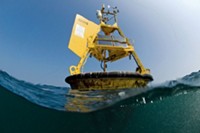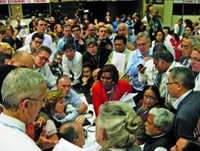Advertisement
Grab your lab coat. Let's get started
Welcome!
Welcome!
Create an account below to get 6 C&EN articles per month, receive newsletters and more - all free.
It seems this is your first time logging in online. Please enter the following information to continue.
As an ACS member you automatically get access to this site. All we need is few more details to create your reading experience.
Not you? Sign in with a different account.
Not you? Sign in with a different account.
ERROR 1
ERROR 1
ERROR 2
ERROR 2
ERROR 2
ERROR 2
ERROR 2
Password and Confirm password must match.
If you have an ACS member number, please enter it here so we can link this account to your membership. (optional)
ERROR 2
ACS values your privacy. By submitting your information, you are gaining access to C&EN and subscribing to our weekly newsletter. We use the information you provide to make your reading experience better, and we will never sell your data to third party members.
Environment
U.S. Actions On Greenhouse Gases
Profound changes in U.S. policies are likely in the next year or two
by Bette Hileman
November 5, 2007
| A version of this story appeared in
Volume 85, Issue 45

DURING THE PAST FEW MONTHS, a storm of U.S. climate-change initiatives has some observers thinking a revolution in attitudes toward legislation to control greenhouse gas emissions is unfolding. Such a broad range of activities may lead within a year or two to profound changes in U.S. policies.
Congress has been involved in an increasing flurry of activity over climate change. Bills have been introduced, resolutions passed, reports released, and hearings held, all dealing with measures to reduce greenhouse gases. To date, 13 bills have been introduced that take varied approaches to reducing greenhouse gas emissions. Some would impose a tax on fossil fuels. Others would set up a mandatory system in which carbon dioxide emissions are capped and gradually reduced through a market-oriented cap-and-trade regime similar to the sulfur dioxide trading system used to control acid rain. Still others would set a target for the percentage of power that must be produced from renewable sources, such as solar, wind, biomass, and geothermal sources.
Most recently, a bipartisan group of senators, led by Sens. John W. Warner (R-Va.) and Joseph I. Lieberman (I-Conn.) introduced a comprehensive bill, America's Climate Security Act, that combines elements of 12 previous climate-change proposals and would affect every segment of the U.S. economy.
Most congressional observers do not expect a major emissions reduction bill with mandatory targets and timetables to become law this year. For this to happen, President George W. Bush's views would have to shift dramatically. But the frenetic activity surrounding climate change and the urgency that many members of Congress attach to the issue may result in passage of a major compromise bill, they say.
"Because you had this revolution in public thought and among members of Congress, we've got a reasonable chance to have a meaningful cap-and-trade system pass both chambers of Congress," says Rep. Jay Inslee (D-Wash.). "Sens. Lieberman and Warner have achieved something I thought impossible one year ago. They have written a climate bill (S. 2191) that has a very real chance of passage," says Eileen Claussen, executive director of the Pew Center on Global Climate Change.
It is the new attitude toward climate change that gives S. 2191 a chance to pass this Congress. Its original sponsors include a broad range of senators almost equally divided between Republicans and Democrats, and it is supported by several major environmental groups and by corporations whose revenues make up a large fraction of the U.S. economy. "With all the irrefutable evidence we now have corroborating that climate change is real, dangerous, and proceeding faster than many scientists predicted, this is the year to move on this critical legislation," Lieberman says.
The bill aims to reduce U.S. greenhouse gas emissions enough between 2007 and 2050 to avert catastrophic global warming. The emissions caps in the bill cover electric power, transportation, and manufacturing sources that together account for 75% of U.S. emissions. The bill would cap greenhouse gases at the 2005 emissions level starting in 2012 and gradually reduce them to 1990 levels by 2020, for a 15% reduction compared with the 2005 emissions level. It requires a 65% reduction from 1990 levels by 2050.
An Environmental Protection Agency analysis conducted in July found that if the U.S. achieves the emissions reduction goals in the bill and the rest of the world achieves the emissions reductions expected under conservative assumptions, the atmospheric level of CO2 would remain under 500 ppm by the end of the century. According to the United Nations Intergovernmental Panel on Climate Change, keeping the concentration below that target will avoid the most severe impacts of climate change.
Although commercial- and residential-sector emissions are not covered by the cap, the measure addresses them by strengthening energy efficiency standards for appliances and buildings.

THE BILL also includes provisions to limit the costs to the U.S. economy. It would set up a politically appointed board of experts similar to the Federal Reserve Board that would have the authority to modify the carbon-trading program if it was causing significant harm to the economy. For instance, the board would allow borrowing of carbon allowances from future years if carbon-trading was severely depressing economic growth.
Some of the revenue from the government sale of carbon allowances would be used to protect low- and middle-income Americans who could suffer most from higher energy prices resulting from the bill, and part of it would be used to deploy advanced technologies to reduce emissions.
Initially, about 80% of the allowances would be given away for free, and the remainder would be auctioned off. By 2036, all the allowances would be auctioned. The bill also includes measures to address negative global warming impacts on resource-stressed populations in other countries. And it directs the President to intensify efforts to convince other nations to start reducing their greenhouse gas emissions.
The heads of several large energy companies praise the proposed measure. "The bill represents another important step toward developing the bipartisan consensus necessary to enact legislation in this Congress," says John W. Rowe, chief executive officer of Exelon Corp. "We believe America's Climate Security Act provides a solid starting point for constructively advancing a comprehensive national response to and policy on climate change," observes Steven L. Kline, vice president for corporate environmental and federal affairs at PG&E Corp.
Major environmental groups, including the National Wildlife Federation, Environmental Defense, the Sierra Club, and the Natural Resources Defense Council also praise the bill but say they would like the emissions targets to be strengthened.
Praise for the legislation is not universal, however. Some Republican senators, industry representatives, and environmental groups are critical. "Unfortunately, the approach introduced by Sens. Lieberman and Warner falls far short of our responsibility" as one of the world's largest greenhouse gas emitters, says Brent Blackwelder, president of the environmental group Friends of the Earth.
A group of Republican senators on the Environment & Public Works Committee, led by climate-change skeptic Sen. James M. Inhofe (Okla.), have sent a letter to committee Chair Barbara Boxer (D-Calif.), calling the bill "potentially troubling" and asking for lengthy public hearings on the legislation. In response, Boxer has promised to convene two hearings and to hold two public briefings on the bill.
Jack N. Gerard, president of the American Chemistry Council, has similar views. "We believe the bill's proposed greenhouse gas emissions reductions are 'too much, too soon' in the absence of a comprehensive energy policy that substantially expands America's fuel diversity and supply."
The United Mine Workers of America opposes the bill, saying it will hurt coal miners and raise energy prices for consumers. The sharp emissions cuts required by 2020 would not give industry time to install technology to capture and store CO2, the union says. The union as well as at least 26 utility companies also want the bill to include a "safety valve," which would put a ceiling on the cost of CO2 allowances so industry and labor would have certainty in their investment planning. The union backs legislation introduced by Sens. Jeff Bingaman (D-N.M.) and Arlen Specter (R-Pa.) that includes such a safety valve.
DESPITE STRONG OPPOSITION, however, the bill now has a fair chance of being passed by the Environment & Public Works Committee as early as this month. That's because Sen. Max Baucus (D-Mont.), considered a key swing vote, decided on Oct. 25 to cast his lot with the other senators who support the bill. Committee members Sens. Bernard Sanders (I-Vt.) and Frank Lautenberg (D-N.J.) have not yet made a decision. They would prefer stronger targets and a larger fraction of the allowances being auctioned at the beginning.
Boxer aims to have the bill approved in committee before the Dec. 3 start of the UN climate-change negotiations in Bali, Indonesia. Such a move, she says, would show that the U.S. has begun the process of setting up mandatory targets for greenhouse gas emissions.
Along with the recent intense activity in Congress has been international discussions on climate change. During the week of Sept. 24, for example, two international conferences on climate change took place. One was held Sept. 24 at the UN headquarters, in New York City, and the other, convened by the White House, was held Sept. 27-28 at the State Department, in Washington, D.C. Participants at both meetings discussed how to structure international agreements to mitigate greenhouse gases, and both included some new elements of discussion on the issue.
The U.S. is serious about tackling global warming, President Bush said at the White House conference. "Energy security and climate change are two of the great challenges of our time," he told delegates from 16 major economies, including the European Union, China, India, Australia, and Japan. Together, these economies are responsible for about 80% of global greenhouse gas emissions.
Bush proposed that a summit of major CO2-emitting countries take place by next summer to negotiate a long-term voluntary goal for reducing greenhouse gases. "By setting this goal, we commit ourselves to doing something about it." he said. Each country should devise its own strategy for achieving the goal, he said.
Bush also proposed that the 16 economies create an international clean-technology fund supported by government contributions to "help finance clean-energy projects in the developing world." Such a fund already exists under the Kyoto protocol on climate change, but Bush did not acknowledge this.
This was the first meeting in the U.S. where Bush said unequivocably that global warming is caused primarily by human activities and suggested setting an international goal for reducing emissions. Just two months before the conference, he had said the human contribution to climate change is uncertain.
European delegates at the conference said they were skeptical about Bush's motives in convening the meeting. They feared he was trying to bypass the UN process for dealing with climate change.
The UN process for mitigating global warming essentially began in 1992 at the Earth Summit in Rio de Janeiro. There, countries negotiated the UN Framework Convention on Climate Change (UNFCCC), which set a nonbinding goal of curbing emissions to prevent dangerous interference with climate. An amendment to UNFCCC, called the Kyoto protocol, was agreed to in Kyoto, Japan, in 1997. In this treaty, the developed nations promised to take on binding emissions targets, reducing their emissions by an average of 5% below the 1990 level by 2012. The protocol expires in 2012, and a successor to the protocol will be negotiated in Bali on Dec. 3-14. The U.S. signed the protocol but never ratified it.
A global reduction of 50% in greenhouse gases "must be the absolute minimum effort ... to limit the risk of the global climate going beyond the famous 'tipping point' of no return," said Mogens Peter Carl, European Commission director general for environment, a delegate representing the 27 members of the EU. And to achieve this goal, the developed nations that are responsible for 80% of the CO2 already in the atmosphere must make firm commitments to reduce their emissions by at least 30% of the 1990 level by 2020 and by 60 to 80% of the 1990 level by 2050, he said.
Quantifiable, verifiable mandatory goals are important for climate treaties, just as such targets are essential in the World Trade Organization, Carl said. No one in WTO would accept a voluntary goal of reducing import barriers, he said. For example, the customs tariffs goals in WTO are legally binding-that is, they must eventually be embodied in national legislation-and enforced by an international body with binding dispute-settlement authority, he said. "Why should the climate-change negotiations be different?" he asked rhetorically.
Most important, he continued, "the world needs quantified binding emissions commitments by developed countries to create a market for carbon." If there is no limit on CO2 emissions, carbon allowances and credits have little or no value, because companies can emit limitless amounts of CO2 without paying a penalty, he noted. Under a cap-and-trade system, companies would purchase or be allocated government-issued credits for each ton of CO2 they emit.
Advertisement
At the New York City conference, meanwhile, representatives of 150 governments, including 80 heads of state, attended a UN-led, one-day climate meeting at UN headquarters. In contrast to Bush's advocacy of a long-term "aspirational" emissions goal, most of the speakers there emphasized the need to take early urgent action. Many delegates stressed the importance of creating a new set of mandatory targets for developed countries to replace those that expire under the Kyoto protocol in 2012.
"This week's historic high-level meeting on climate change has galvanized world leaders to take urgent action to stem global warming," UN Secretary-General Ban Ki-moon said. "The leaders of the world have shown that combating climate change needs political leadership at the highest level."
The event "represents a sea change in the response to climate change," Ban said. "In all discussions today, leaders have indicated that we need to step up the pace. We are fast running out of time if we want to avert the most catastrophic consequences the Intergovernmental Panel on Climate Change has projected." he said. The New York City meeting generated major momentum for the UN climate-change negotiations in Bali, he observed.
Also adding to the momentum is the fact that the business community's views about climate change are beginning to converge, Yvo de Boer, executive secretary of UNFCCC, said during a discussion at the Brookings Institution last month. Business executives of the member companies of the U.S. Climate Action Partnership have urged President Bush to support a mandatory cap on greenhouse gas emissions and to cut them by more than 60% from the 1990 level by 2050. (The partnership is composed of companies and environmental groups that have come together to press for mandatory caps on emissions.) "And that is very similar to the business voice that you have in Europe, Australia, and Canada," de Boer explained. The private sector is calling "for long-term clarity, for a clear indication of where governments intend to go."
Another important development is that U.S. states have come together on the issue of climate change, de Boer said. States that produce about 24% of U.S. emissions—including California, Oregon, Washington, and the New England states—have decided to establish cap-and-trade programs for greenhouse gas emissions, and the National Governors Association agreed in September to expand state regulations limiting greenhouse gas emissions, he said.
ON THE REGULATORY FRONT, EPA is planning to propose rules increasing the corporate average fuel economy standards for motor vehicles. In early 2008, EPA will announce formally that CO2 endangers U.S. health and welfare, a statement that will be consistent with the recent Supreme Court decision on CO2, says Nancy Kete, managing director of the Center for Transport & the Environment at the World Resources Institute. "The agency will aim for a 4% improvement in fuel economy per year beginning in 2010," she says. To meet the standard, EPA will allow fuel companies and vehicle manufacturers to trade fuel economy credits among themselves, she explains. EPA confirms that it is working on new fuel economy standards, but it does not say what those standards will be.
This time in U.S. history, Kete says, is very similar to the months right before the passage of acid rain legislation in 1990. Then, many utilities were advocating for a bill so they would have a more certain investment climate. Today, several utilities and other large companies, including Alcoa, General Electric, Ford, Chrysler, General Motors, Dow Chemical, DuPont, BP America, ConocoPhillips, Royal Dutch Shell, Duke Energy, and Exelon, are pushing for passage of the Lieberman-Warner bill. They want goals and a framework for making investments, she says, and have promised to work with Boxer and other members of the Environment & Public Works Committee on advancing the legislation.
New developments occur daily. For example, on Oct. 29, an international partnership was announced to share experiences on restricting CO2 emissions through carbon-trading schemes. The members include European countries, U.S. states, Canadian provinces, and New Zealand. The multiplicity of climate-change initiatives on many different fronts—in Congress, internationally, among states, and within EPA—will undoubtedly lead to changes in U.S. emissions policies in the near future.





Join the conversation
Contact the reporter
Submit a Letter to the Editor for publication
Engage with us on Twitter